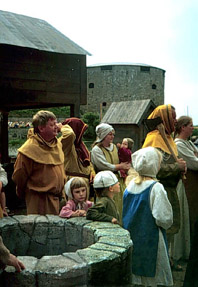Meet the Middle Ages
BackThe town and the king

Kings and emperors have always wanted to rule the towns. During the 14th and 15th century, all Swedish towns were under the influence of and subjected to the King. The Bailiff was the King’s extended arm in a town. He supervised the work of the Council and made sure that the King received his share of the fines that the court had ordered criminals to pay. Even though the Chief Magistrate was the chairman of the Council, no decisions could be taken without the Bailiff being present.
No place could be called a town without having been granted a town charter. The oldest remaining town charter in Sweden was that of Jönköping, which was granted in 1284. Town charters had been issued before, but these documents no longer exist.
From the 1350 ´s and onwards, all Swedish towns were administered according to the same law, the Town Law of Magnus Eriksson. The King was behind this law and this increased his control over the towns. Until then, all towns had had their own laws.
In Denmark the case was different. There, all the towns continued to have their own laws. The Town Law of Ribe was considered the strictest. There is an old saying: "Lucky you that you weren’t under Ribe law, said the old woman who saw her son swinging from the Vandre gallows"..
In Northern Germany there were free towns, for example Lübeck, Bremen and Hamburg, which weren’t ruled by the Emperor. In the small German duchies, like Mecklenburg, Pommern and Holstein, the prince or duke often lived in town, ruling it as well. These small principalities paid tax to the Emperor, too.
The towns gave large profits to the Crown. All citizens paid taxes and there were duties on trade. The citizens paid taxes according to their means. If they were rich, their taxes were high. The Crown made its greatest profits from the duties.